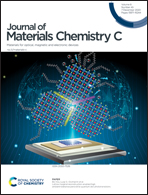Piezoelectric Ba and Ti co-doped BiFeO3 textured films: selective growth of solid solutions or nanocomposites†
Abstract
Metal organic chemical vapor deposition (MOCVD) is exploited as a synthetic route to produce Ba and Ti co-doped BiFeO3 thin films. A facile approach based on a molten multi-component source, consisting of a Bi(phenyl)3, Fe(tmhd)3, Ba(hfa)2·tetraglyme and Ti(tmhd)2(O-iPr)2 (phenyl = –C6H5, H-tmhd = 2,2,6,6-tetramethyl-3,5-heptandione; O-iPr = iso-propoxide; H-hfa = 1,1,1,5,5,5-hexafluoro-2,4-pentanedione; tetraglyme = CH3O(CH2CH2O)4CH3) mixture, is applied for the MOCVD based fabrication of doped BiFeO3 films on SrTiO3:Nb(100) substrates. The applied characterization techniques, such as X-ray diffraction (XRD), transmission electron microscopy (TEM), X-ray photoelectron spectroscopy (XPS), field emission scanning electron microscopy (FE-SEM) and atomic force microscopy (AFM), provide a suitable correlation between processing parameters/precursor mixtures and the nature of the deposited films, in terms of the formation of solid solutions of the type Bi(1−x)BaxFe(1−y)TiyO3vs. the formation of Bi(1−x)BaxFeO3/Bi(1−x)BaxFe(1−y)TiyO3 nanocomposite films. Piezoresponse force microscopy (PFM) is applied to correlate the nanostructure/composition and piezoelectric/ferroelectric properties.



 Please wait while we load your content...
Please wait while we load your content...